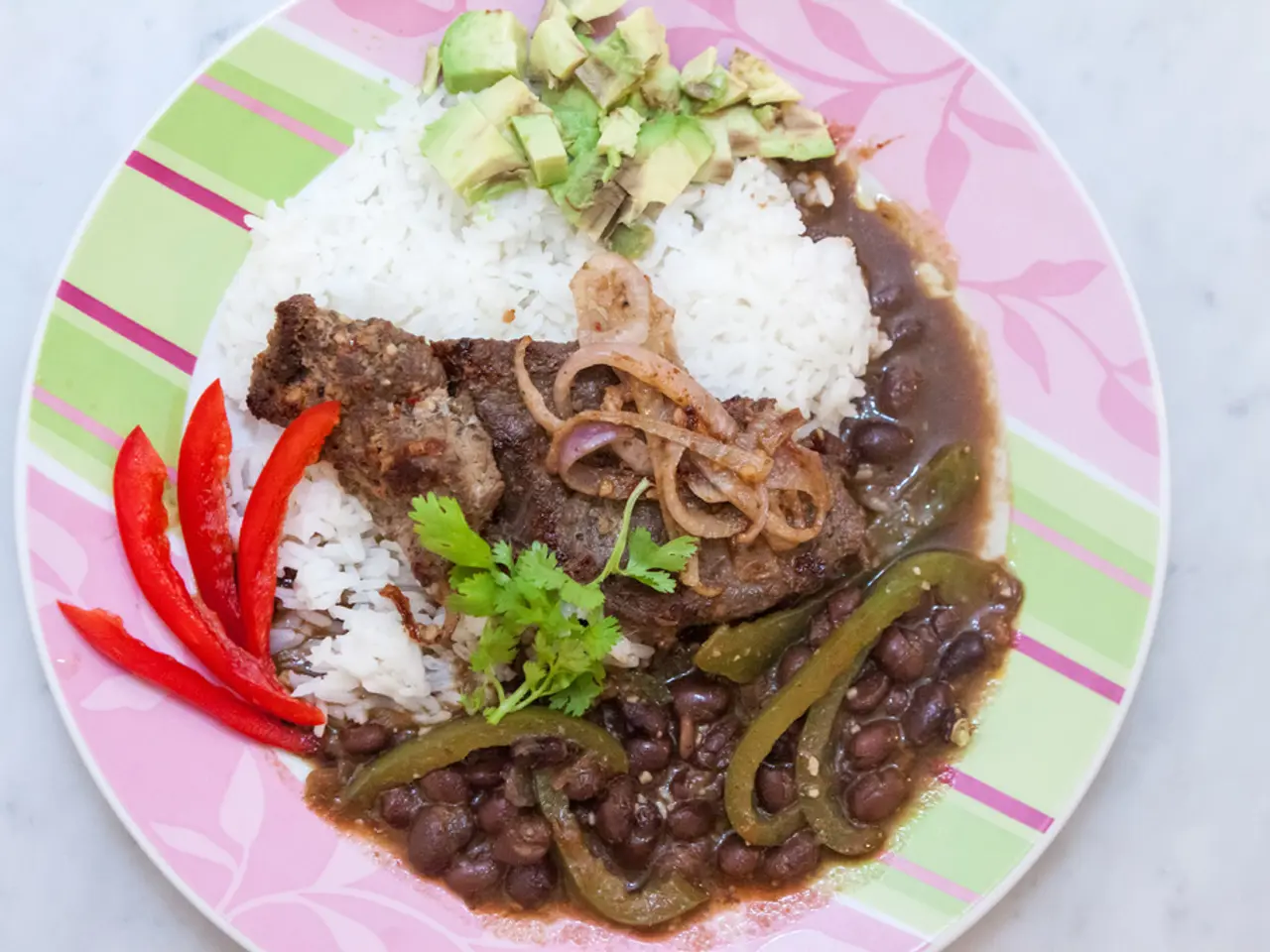Low-fat foods: Comprehensive guide, advantages, and meal plan outline
A low-fat diet, when followed correctly, can offer numerous health benefits and contribute to a healthier lifestyle. Contrary to popular belief, not all fats are unhealthy; polyunsaturated fats (such as omega-3 and omega-6 fatty acids) and monounsaturated fats are beneficial to the body. These beneficial fats can be found in foods like salmon, avocado, almonds, cashews, seeds, tahini, walnuts, as well as beans, lentils, tofu, egg whites, lean cuts of meat, shrimp, and skinless chicken or turkey breast.
Following a low-fat diet can aid in lowering overall calorie intake, which can be advantageous for weight management. A low-fat meal plan could include oatmeal with honey, frozen blueberries, raisins, and orange juice for breakfast; a tuna and cucumber wrap, a boiled egg, and low-fat vanilla yogurt for lunch; spaghetti with homemade tomato sauce, vegetables, and lean meatballs or a vegetarian alternative for dinner; and carrot sticks with hummus dip or whole grain crackers as snacks.
The benefits of a low-fat diet extend beyond weight management. A study suggests that a healthy low-fat diet can lower the risk of all-cause mortality in individuals with hypertension, compared to unhealthy versions which may increase risk[1]. Additionally, low-fat diets are associated with favourable baseline metabolic profiles, contributing to better health outcomes[1].
Potential weight loss and weight management benefits, especially with low-fat vegan diets that may reduce dietary acid load, promoting weight loss independent of calorie intake and improving conditions linked to inflammation such as obesity, gout, and arterial diseases, are also associated with low-fat diets[3]. Furthermore, a low-fat diet can alleviate or manage conditions such as gallbladder disease, delayed stomach emptying (gastroparesis), diarrhea, and fatty liver disease, where reduced fat intake is beneficial[5].
When it comes to foods considered low in fat, generally, low-fat diets recommend trimming visible fat from meats[5]. A low-fat vegan diet focusing on plant-based foods can reduce fat intake and dietary acid load, which is beneficial[3]. Other sources suggest that low-fat options often include fruits, vegetables, whole grains, and plant proteins, while healthy fats like nuts and oily fish are more related to fat-burning and metabolism-enhancing diets rather than low-fat diets per se[2].
It's important to note that dairy products can be low fat if they are fat-free, skim, light, or low-fat versions. Examples of low-fat dairy products include fat-free cheese, skim milk, low-fat yogurt, and low-fat cottage cheese. Fruits and vegetables are naturally low fat.
For those seeking guidance on the type of diet they should follow for their health, it's recommended to consult a healthcare professional. The American Heart Association recommends consuming 3 servings of low-fat or fat-free dairy products, 4 servings of fruits, up to 3 tablespoons of polyunsaturated or monounsaturated oils, 1-2 servings of proteins, 5 servings of vegetables, 3-6 servings of whole grains daily.
Diets high in fat from processed and fast foods tend to have less nutritional value than lower fat diets that include a mix of fresh fruits, vegetables, whole grains, and lean proteins. To determine if a food is low fat, one should read its nutrition label. When preparing meals, using a non-stick pan may help reduce the amount of oil necessary. Nondairy yogurts can also be low fat. Eliminating unhealthy fats can have a positive impact on a person's weight, heart health, and overall well-being. MyPlate.gov offers samples of 2-week menus of low-fat meals for those seeking meal planning guidance.
- A low-fat diet, beneficial for weight management and overall health, includes foods like salmon, avocado, and almonds, which are rich in polyunsaturated and monounsaturated fats.
- Not all fats are unhealthy; even food items like tahini and walnuts contain healthy fats that can contribute to a healthier lifestyle.
- A study suggests that a healthy low-fat diet can lower the risk of all-cause mortality in individuals with hypertension.
- Low-fat diets are associated with better health outcomes, thanks to their favourable baseline metabolic profiles.
- Potential weight loss benefits and improved conditions linked to inflammation such as obesity, gout, and arterial diseases are associated with low-fat diets.
- When it comes to weight management, a low-fat diet can aid in lowering overall calorie intake, making it effective for weight management.
- A low-fat meal plan could include oatmeal, frozen blueberries, raisins, and orange juice for breakfast, spaghetti with vegetables and lean meatballs or a vegetarian alternative for dinner, and carrot sticks with hummus dip as snacks.
- Low-fat diets recommend trimming visible fat from meats and focusing on plant-based foods for a low-fat vegan diet.
- Dairy products like fat-free cheese, skim milk, low-fat yogurt, and low-fat cottage cheese are examples of low-fat dairy products.
- Fruits and vegetables are naturally low fat and are crucial components of a low-fat diet.
- Consulting a healthcare professional is recommended for those seeking guidance on the type of diet they should follow for their health.
- The American Heart Association recommends consuming 3 servings of low-fat or fat-free dairy products, 4 servings of fruits, up to 3 tablespoons of polyunsaturated or monounsaturated oils, 1-2 servings of proteins, 5 servings of vegetables, 3-6 servings of whole grains daily.
- Diets high in fat from processed and fast foods tend to have less nutritional value than lower fat diets that include a mix of fresh fruits, vegetables, whole grains, and lean proteins.
- Read the nutrition label to determine if a food is low fat, and using a non-stick pan can help reduce the amount of oil necessary when preparing meals.
- Nondairy yogurts can also be low fat and can be beneficial for your health and well-being.
- Eliminating unhealthy fats can have a positive impact on a person's weight, heart health, and overall well-being.
- MyPlate.gov offers samples of 2-week menus of low-fat meals for those seeking meal planning guidance, making it easier to adopt a low-fat diet and integrate healthy cooking and food choices into their lifestyle, promoting global cuisines, personal growth, mindfulness, career development, and skills training.




